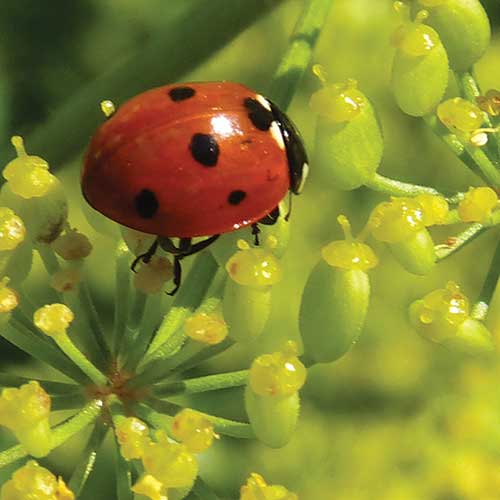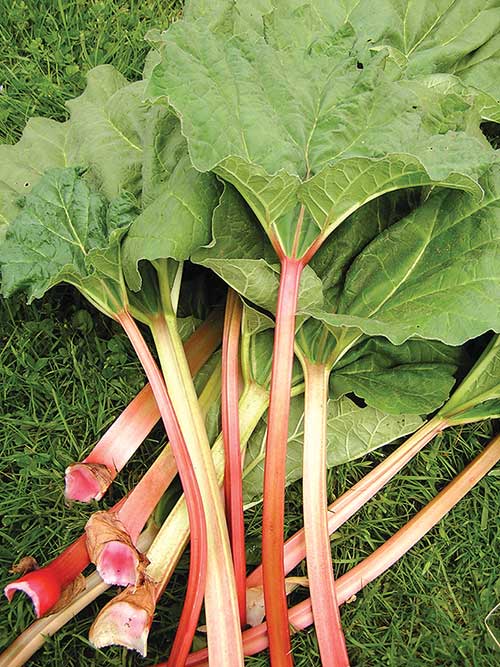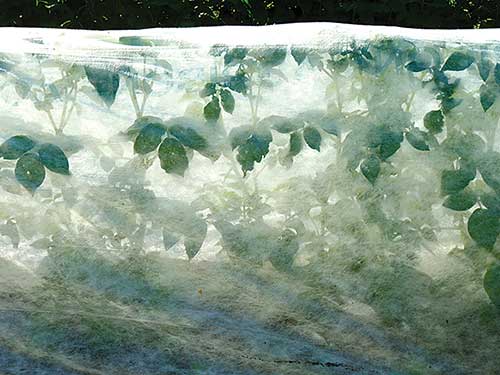 |
| One way to manage pest insects is to create habitat in your garden for beneficial insects such as ladybugs. |
 |
| Oxalic acid in the leaf blades (not petioles) of rhubarb can help repel flea beetles. |
 |
| Row cover, although a synthetic material, can last several years with care. |
 |
| An infusion of tansy, growing here with goldenrod, may repel Colorado potato beetles. |
By Will Bonsall
Photos by Jean English
Note: The Maine Board of Pesticides Control says, “Even homemade products used to control pests are considered pesticides and are regulated in some circumstances.” Also, when using pesticides on crops grown commercially and intended for human consumption, an applicator’s license may be required. See this Maine Board of Pesticides Control site. Finally, certified organic producers should check with their certifier before using any pesticides not mentioned on their organic farm plan.
One of the most persistent problems in growing food is pest control: how to contend with the other sentient beings who love your food as much as you do.
Oh sure, I hear people say, “If your soil is healthy enough, your plants will be so strong and vital that pests will just leave them alone and go after weaker, sicker ones.” That may be true to a large extent with diseases, but insects are another matter. After all, if the healthy soil argument were completely true, you wouldn’t want to eat the vegetables yourself because from the point of view of a cabbage, you are a pest. When a stressed cabbage plant puts out distress signals in the form of bitter chemicals, you don’t hone in on it – you reject it. Suffice it to say that however healthy your crop plants, you will have competition for them. In many cases the damage may be slight enough to ignore, but some problems don’t go away; they just get worse until someone or something breaks their cycle.
By the way, this article is concerned only with pests of a “wee beasties” nature; birds and mammals will wait for a future article.
I have pests, lots of them. In fact sometimes I’m surprised that I don’t have some of the pests other gardeners complain about. Or maybe I’m just unobservant, but if a pest is so unnoticeable, how bad is that? I hear about tarnished plant bugs (TPB), diamondback moths and nematodes, but I don’t see them. Is it just me? TPBs are the bane of many seed crops, and I certainly do grow seed crops. Diamondbacks are a nuisance with quinoa, which I occasionally grow, but it’s supposedly endemic in wild lamb’s quarters (which I harvest as a major crop in the corn), so how could I miss it or its damage? And sure, my soil is probably crawling with nematodes, including some bad ones, but its high humus content (due to relying on plant residues rather than manure for building soil) apparently teems with enough beneficial nematodes to keep the baddies in check. So perhaps in some cases ignorance is bliss; however, enough pests do threaten my crops that I’ve worked out many coping strategies, which I’ll share, although they are by no means exhaustive and often are not panaceas but mitigatory.
Some general control strategies include maintaining high soil humus, mulching, growing diverse crops, companion planting and rotating, and encouraging beneficial pollinators and predators (fireflies, ladybugs, etc.). Regarding that last, I always prefer beneficials that either are already here and only need encouraging habitat or, if imported, can become established and not require regular replacement. In my location, trichogramma wasps, lacewings and mantises don’t seem to take hold, and it seems kind of unfriendly to bring in mail-order insects knowing they’ll all die come winter. In fact I’m reluctant to bring in lots of any stuff from away that undermines my self-reliant focus, although compromise is not always bad.
Rhubarb-Based Repellent
Here’s an example: Flea beetles are often a nuisance on my cruciferas, especially those early-planted crops, and more especially direct-seeded ones. Stress, especially drought, is a great signal to flea beetles, so good, humus-y, well-watered and mulched soil will help, but often not enough. So I have my own repellent.
The high level of oxalic acid that makes rhubarb leaf blades (not petioles) toxic to people and many other critters is also something of a turnoff to flea beetles. It doesn’t kill them any more than it would kill you to eat a lot of it, which you wouldn’t do because of the taste. Well, flea beetles seem to operate on the same philosophy – if it tastes gross, just move along. By the way, as a basically decent fellow, I like to avoid mass murdering other beings, but I also love to eat, so when necessary I wreak mayhem, but whenever I can simply shoo pests away, I really prefer that. That accounts for my liking of diatomaceous earth (DE), garlic barrier, row covers and other such exclusionary deterrents, which I’ll mention later.
Back to rhubarb: I pull the leaves, cutting and using the stalks if desired (although the leaves are what I really care about), chop and add them to boiling water for several minutes, cool and strain the liquid so that any solids are fine enough that they don’t clog the sprayer head. I spray flea beetle-susceptible crops two or three times, allowing each application to dry before adding the next to avoid beading up and running off. This treatment seems to last through several rains even though the oxalate is quite soluble; I suspect the juice has pectins and other components that act as a binder. Usually a single treatment will suffice, since once the seedlings become well established, the beetles seem to have moved on or perhaps broken their cycle.
Before discovering this rhubarb treatment, I used to put dry wood ashes in a burlap bag and shake them lightly over the plants, which gave good results at least for a while. That also seemed to help with root maggots in radishes and turnips.
Row Covers
Another exclusionary method – for crucifers and many other crops – is a row cover such as Reemay. That’s made from spun-bonded polyester. I’m always loath to use petroleum-based materials on my land – especially those that are discarded and replaced annually. But unlike black plastic sheeting, which strangles the soil and impedes natural rain penetration, Reemay can be used again and again. Yes, it snags easily and gets holes, but I’ve learned to use it in ever-smaller pieces (such as on hill-planted squash and melons), so I get several years’ use out of it. The finer mesh row covers (such as Typar) tend to raise the temperature several degrees, but for crops such as melons that may be a plus.
Garlic
What other pests can we repel without killing? Some years – not all – bring attacks from leafhoppers, especially troublesome in favas and potatoes. Spraying a film of garlic extract (sold as Garlic Barrier) is pretty effective, at least while it lasts. Happily, the leafhopper attacks don’t usually last the whole season; in fact they’re mainly a concern when the looping jet streams sweep them up this way from farther south. Reemay is effective on younger fava plants but awkward as they grow taller – my favas often reach 3 to 4 feet – and a pain when you need to pick the pods almost daily.
Home-Grown Repellents
Some botanical repellents are quite effective, especially those involving essential oils. However, those are expensive and tend to evaporate too quickly, so I’ve searched for home-grown substitutes. For example, mint plants are supposed to repel cabbage moths (which become cabbage worms, making broccoli quite unsaleable); indeed they seem to help a lot. But if I interplant mint and crucifers, then I have a mint patch to eradicate for the next couple of seasons. I get similar results by cutting mint sprigs from my separate patch and laying them atop the cabbage family plants. They wilt immediately but continue to emit volatile oils for a few days and can be replaced easily. I’ve also used cedar twigs, which seem to last a lot longer.
Purchased Organic Insecticides
With some lepidoptera (moths and butterflies), such as tomato hornworm, killing seems the only remedy. Then Bt (Bacillus thuringiensis) is a handy tool. It is laboratory-grown somewhere else and a pretty gruesome way to die, but when you see a maturing crop of tomatoes being decimated by those huge thugs, it’s hard to feel sympathy. A downside is that Bt kills any lepidoptera larva, including some very lovely and rare species, but since those harmless flutter-bys don’t usually hang out around my crops, they’re in little danger.
Speaking of purchased organic pest remedies, perhaps the simplest to use is PyGanic, an extract of a chrysanthemum, Tanacetum cinerariaefolium. “Simple” because it is easy to use (spray or dust), quick acting and works for nearly everything. But that’s the problem: “Nearly everything” may include harmless insects, helpful pollinators, the fish in your farm pond and even you; “organic” doesn’t necessarily mean nontoxic. A good feature is that PyGanic is very short-lived, breaking down to harmless byproducts within 24 hours. It’s safe enough for the consumer but potentially a risk for the applicator if used carelessly, so use it advisedly if at all, and try to use less broad-spectrum alternatives. That being said, I use PyGanic mainly for Mexican bean beetles, although even those can be minimized by thoroughly freezing the seeds during winter (not in a freezer – too mild – but in a trash can stored outside).
Potato Beetle, Slugs, Cucumber Beetles
For Colorado potato beetles, I’ve usually relied on hand-picking, which is effective but time-consuming, especially with large crops. Cousin Tom Vigue has discovered a repellent that I intend to try. He scrunches up a lot of fresh tansy to make a smelly infusion that he sprays on the younger plants. He says once the beetles are established, it’s practically useless, but as a preventive it’s perfectly effective. Incidentally, deep mulch (instead of hilling) helps a lot – not completely – and an extract of horseradish can be helpful.
The usual remedy for slugs is pans of stale beer for them to crawl into and drown (I doubt the “stale” part is critical; rather that no one wants to part with beer that’s not stale). I don’t mind killing the nasty things, but as a teetotaler myself, I hate to corrupt their morals, so I prefer to sprinkle DE, either on them or on the plants – the latter at least gives them a chance to avoid the microscopic glass shards that tear up their bellies. Be sure not to breathe DE; it can harm your lungs.
For striped cucumber beetles I have a unique and inexplicable solution. As soon as the snow leaves, I sow a green manure crop of oats, raking or treading it into the mud just enough to hide it from newly arrived birds. Even after planting the hills of squash, pumpkins, cukes or melons, I allow the surrounding oats to continue growing until early July, when the vines start to sprawl. At that time I flatten the oats (which may be 2 feet tall) by flopping down a half-sheet of plywood and treading on it, then covering the flattened oats with a layer of leaves followed by a little hay to keep them from blowing. In addition to complete weed control and massive additions of organic matter (my original reason for doing it), for reasons I’ll never understand, I have no stripers on that patch.
These ideas are hardly comprehensive but may help someone. In a future article I’ll cover larger pests, such as birds and mammals.
About the author: Will Bonsall lives in Industry, Maine, where he directs Scatterseed Project (https://www.scatterseedproject.org/#scatterseed), a seed-saving enterprise. He is the author of “Will Bonsall’s Essential Guide to Radical Self-Reliant Gardening” (Chelsea Green, 2015). And indeed, he is also a distant cousin of another exemplary Maine horticulturist: Tom Vigue. You can contact Will at [email protected].
